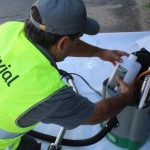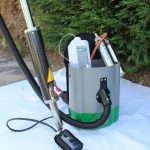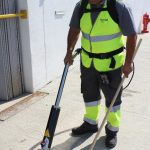
Soft, colourful, sticky, these are just some of the characteristics of chewing gum. But it’s probably the last of these that people find most irritating. Just think how often you’ve been walking along the street when suddenly a sticky gob of gum stops you in your tracks. You just know what your reaction will be. A combination of selfishness and carelessness that not only makes our pavements stickier, as it’s also estimated that each piece of gum contains 50,000 pathogenic bacteria. This is so true that you won’t be surprised to hear that the import, manufacture, sale and consumption of chewing gum have been banned in Singapore since 1992.
As we still have the right to chew gum, it is a must to clean the streets thoroughly and remove gum from the pavements; although the sticky factor involved makes this quite complicated.
Scrub or die?
As if in some kind of soap ad, where “scrubbing is a thing of the past”, a new generation of methods have appeared for removing sticky chewing gum. This is the case of Gumpak, the new way of removing chewing gum from the streets of Maia (Portugal).
What is Gumpak?
The >Ferrovial Serviços cleaning staff in the Portuguese city of Maia have a strange device that an operator uses to remove on average three pieces of chewing gum per minute, which means over a thousand gobs per day!
As opposed to the traditional systems for removing chewing gum that involve scrubbing, this tool consists of a backpack and brush, and it is extremely easy to use. What’s more, not only can it be used outdoors, but also inside buildings such as airports, shopping centres, hypermarkets… as it hardly makes any sound, reducing noise levels to a minimum.
A beetroot-based biodegradable solution
But the truly amazing thing about Gumpak is what it contains: a pH neutral biodegradable cleaning solution that is non-corrosive, safe, and phosphate-free. It does not generate any waste, and it’s made with beetroot extract! The advantages of using this cleaning product contrast with the recurring use of environmentally harmful chemical products.
A Gumpak consists of a carbon fibre container that holds the detergent, two canisters of LPG, which is a mixture of butane gas and propane, and a battery (rechargeable at any power point, with a life of 8 to 12 hours). It also has a pressure hose for spraying the heated solution, and the power and flow are easily adjusted by a remote control handset. The equipment weighs around 6 kg, and is fitted with padded straps and a belt to make sure it can be worn comfortably.
How does it work?
The first step is to check the backpack is fully loaded with detergent and LPG, and then the operator turns the device on and waits for about three minutes until it reaches its ideal operating temperature. The next step is to adjust the flow of solution, and then spray the chewing gum. After two or three seconds, the warm liquid acts upon the gum, which disintegrates in contact with the wire brush. Finally, the whole area where the gum was stuck is swept to make sure all the tiny fragments remaining from the process are dispersed.
When operating, the equipment does not need to be connected to the mains power or water supplies. Neither does it require additional signage or blocking off pedestrian areas, so it does not interfere with people’s everyday lives.
A complement to traditional cleaning in cities
This original way of removing gobs of gum from the pavement is the perfect complement for all the traditional urban cleaning services that the Portuguese subsidiary of Ferrovial Servicios undertakes, such as the cleaning of wheely bins, the sweeping and hosing of streets, and the application of herbicides. It is so inventive and unusual that it has even attracted the interest of the Portuguese media (watch from minute 19:36 to 22:51):










There are no comments yet